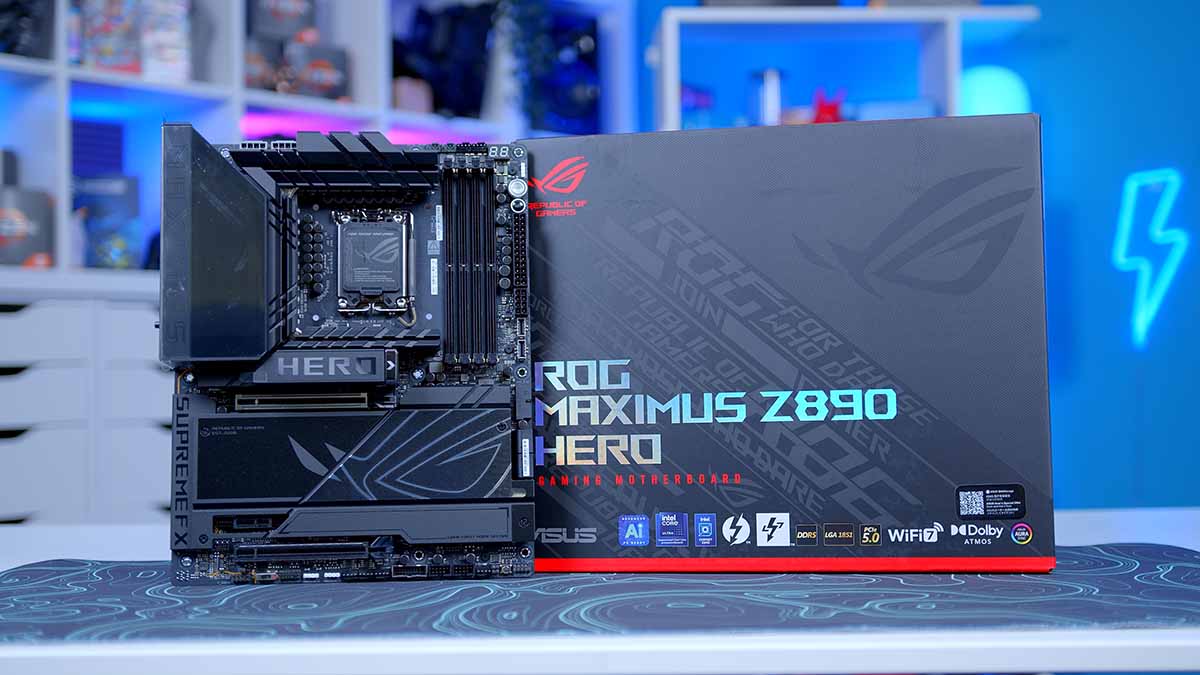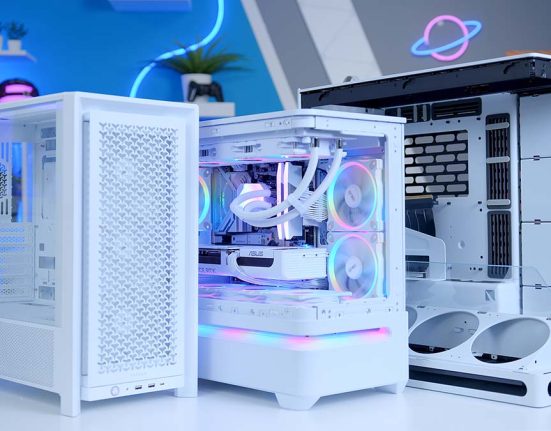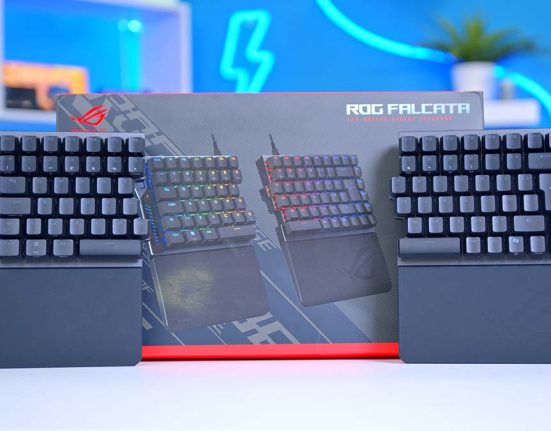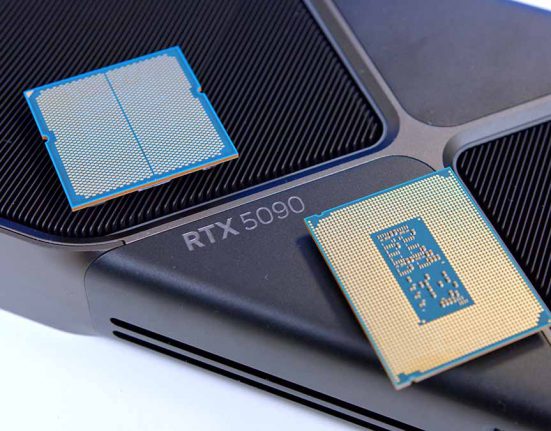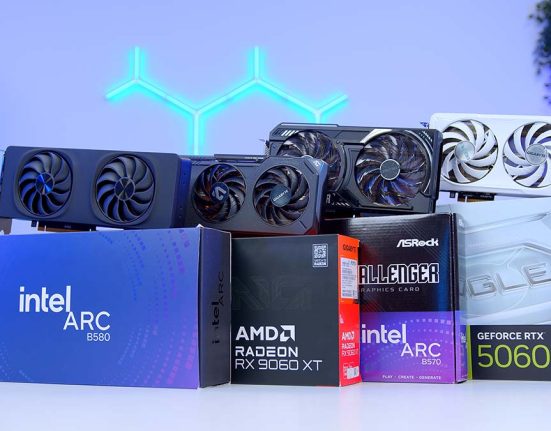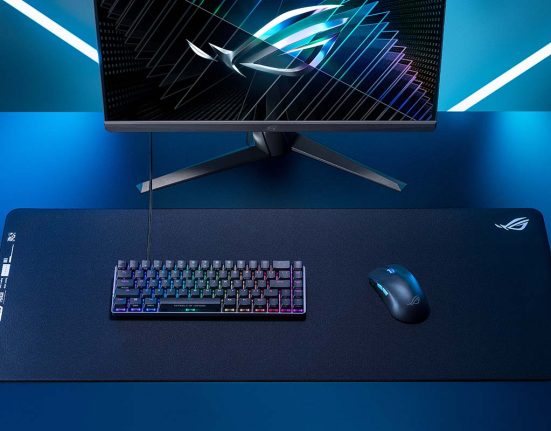The ASUS ROG MAXIMUS Z890 HERO is an enthusiast-level motherboard available alongside the Intel 15th-Gen range of CPUs. This is a flagship option from ASUS, catering to those looking for the best performance, connectivity, and expansion that money can buy. This means the ROG MAXIMUS Z890 HERO has features such as a 22+1+2+2 VRM power phase design for extreme CPU overclocking, six M.2 slots, an expansive array of high-speed IO, and much more. We’ve tested it to determine where this board stands compared to its predecessor on the Z790 chipset, analysing its specs, features, and design.
The 15th-Gen series of CPUs is the foundational offering on the LGA1851 socket. It offers a marked improvement in efficiency but is similar to the performance of the previous generation. This means that while many of the features on the Z890 chipset aren’t new, they have seen more refinement, allowing motherboard manufacturers to offer better performance and configuration options. For this reason, it’ll be interesting to see what’s changed from the previous Z790 generation.
This motherboard review examines the ROG MAXIMUS Z890 HERO, including the specs, additional box accessories, design, connectivity and expansion, and internal headers.
Buy the ASUS ROG MAXIMUS Z890 HERO on:
Specification
One significant difference between the ROG MAXIMUS Z890 HERO and the Z790 HERO is overclocking support. The Z890 features a whopping 22+1+2+2 VRM power phases, which is an additional 2+2 phases compared to the Z790 version. This allows enthusiasts to push overclocking even further than before, sustaining high speeds with some trial and error. The same applies to the RAM capability, with DDR5 speeds maxing out at 8800MT/s on the Z890 HERO, which is 1000MT/s more than the Z790 version of this very board.

PCI-E expansion for graphics cards is pretty similar between both boards. The Z890 features a single Gen5 slot, with an extra Gen4 slot that runs at x4 speeds. The Z790 version did offer dual Gen5 compatibility, but considering there are more M.2 slots on this board, the lack of an additional GPU slot isn’t a deal-breaker for us. Speaking of storage, the ROG MAXIMUS Z890 HERO has six total slots: three Gen5 and three Gen4. One of the big caveats of the Z790 HERO is that it only has three slots, and Gen5 was only accessible through an expansion card. So, it’s great to see many storage slots directly on the board.
The front IO selection is pretty similar to what’s available on the Z790 HERO, bar the addition of an extra USB 3.2 Gen2 Type-C port. Strangely, the rear IO has received a slight downgrade on the Z890 HERO. There are twelve ports in total: two Thunderbolt 4 ports, five USB 3.2 Gen2 ports, and four USB 3.2 Gen1 Type-A ports. While this board only has one less USB 3.2 Gen2 port, it’s still an odd feature to downgrade.
| Specification | ASUS ROG MAXIMUS Z890 HERO |
|---|---|
| Form Factor | ATX |
| Supported Memory | 192GB DDR5 9200MT/s |
| PCI-E x16 Slots | 1 x PCI-E 5.0 1 x PCI-E 4.0 |
| PCI-E x4 Slots | 3 x PCI-E 5.0 3 x PCI-E 4.0 |
| VRM Power Phases | 22+1+2+2 |
| Front IO | 1 x USB 3.2 Gen2x2 Type-C 1 x USB 3.2 Gen2 Type-C 2 x USB 3.2 Gen1 Type-A 2 x USB 2.0 |
| Rear IO | 2 x Thunderbolt 4 Type-C 4 x USB 3.2 Gen2 Type-A 1 x USB 3.2 Gen2 Type-C 4 x USB 3.2 Gen1 Type-A |
| Audio | 1 x Optical S/PDIF 2 x Audio Jacks |
| Networking | 2.5 Gigabit LAN 5 Gigabit LAN WiFi 7 |
On the networking front, the ROG MAXIMUS Z890 HERO has received a slight upgrade to the WiFi 7 compatibility. WiFi 7 has become the standard across most modern boards and offers better stability and bandwidth if you have a supporting router. This board also has an extra 5 Gigabit LAN port, compared to the single 2.5 Gigabit LAN on the Z790 HERO. This is great for those with a home server setup. Audio is pretty basic, with one optical S/PDIF and two 3.5mm jacks. Again, this is another downgrade compared to the Z790 HERO, which is a strange choice.
What’s in the Box?
Before we delve into the design, it’s worth looking at the box accessories. Manufacturers often include extra gadgets and cables inside the box to make the PC-building process easier.
First is the WiFi 7 antenna. Any motherboard with onboard WiFi will include an antenna, as this maximises the range output. The antenna itself looks pretty similar to other designs, but it also utilises a snap-in connector which saves the hassle of having to screw it in.

Next are the various Q-latches and connectors. As we’ve seen with our X870 motherboard reviews, there’s a big push with the new motherboards to utilise more DIY-friendly features. These minimise the use of tools and make installing components a straightforward process. For example, the Q-latch holds the SSD in place without any screws. The Q-slide provides a way to install smaller SSDs across all slots, and the SSD Q-release allows you to take off the SSD heatsink with the push of a button.

This board comes with an ASUS-themed USB stick with various utilities and drivers. This is particularly handy if you don’t have access to the internet when setting up your PC.

There are a couple of extra accessories worth noting that come with the Z890 HERO motherboard. It features a DDR5 fan holder, offering a way to keep your RAM DIMMs cool. The ARGB extension cable provides extra slack to those looking to install multiple lighting accessories. There are also some stickers, a bottle opener, and a thank you card. While the last three don’t do anything for the building process, they’re novelty items that make this board stand out.

ASUS ROG MAXIMUS Z890 HERO Design
Because this is one of ASUS’s most expensive motherboards, they’ve put plenty of effort into making it look good. This board dons a black design across all the heatsinks and the PCB. On the heatsinks, you’ll find various ROG livery etched in a slightly lighter colour, which provides some decent contrast to the overall look of the motherboard.

Much like the ROG Crosshair X870E, the ROG MAXIMUS Z890 HERO’s design is akin to the older Dark Hero range, which I’m a massive fan of. ASUS has done a great job honing the dark theme, and this board blends in very well with other black components.

You’ll find all the RGB goodness on top of the rear IO heatsink. The right side of the heatsink is dedicated to RGB, providing vibrant lighting for your build. This can be customised within the ASUS Armory Crate software or SignalRGB. It’s a shame that the rear IO heatsink doesn’t feature a screen, especially based on price. However, the idea of a screen won’t appeal to everyone.

On the whole, I’m a big fan of this board’s aesthetic. The dark theme is excellent, and it looks incredibly sleek and consistent across the entire PCB. I think the amount of heatsink coverage is solid. Some high-end motherboards often lack heatsinks to cover up the connections underneath, but the Z890 HERO does a good job of hiding the more rugged elements of a motherboard.
Connectivity Options
Graphics Card Slots
As mentioned in the specs section of this article, graphics card expansion options have oddly been downgraded compared to the previous generation Z790 HERO motherboard. That being said, the Z890 HERO still offers a Gen5 GPU slot, which means it is well-prepared for PCI-E 5.0 graphics cards when they hit the shelves. The lack of dual-GPU compatibility is a shame, but other Z890 motherboards support this.

M.2 Slots
Regarding storage, there are ample expansion options here. This board supports six M.2 SSDs in total, three of which are Gen5 slots, and the other three are Gen4 slots. The primary SSD slot is located underneath the large heatsink towards the top of the motherboard. This is a Gen5 slot, and any drive installed here can be added without the use of tools.

Moving down, the large heatsink that spans the width of the motherboard houses four SSD slots, three on the left and one on the bottom right. The top drive here is Gen4, and the two underneath are Gen5. The slot on the bottom right is also Gen4. It’s worth highlighting that the large SSD here isn’t tool-less, but it can be easily removed by loosening two screws.

The final slot, on the right-hand side, is underneath the smaller heatsink towards the bottom of the Z890 HERO motherboard. It is the final Gen4 slot.
Underneath motherboard power is an 8-pin PCI-E header. This is specifically built for the M.2 slots on this board. When plugged in, it delivers additional power so that all onboard M.2 devices can operate optimally.

RAM DIMMs
Like the other Z890 motherboards we’ve reviewed, the ROG MAXIMUS Z890 HERO uses a pretty standard RAM configuration. It supports four DIMMs with a max capacity of 192GB clocked at 8800MT/s. As we’ve seen with X870 boards, ASUS boards seem to be limited to 192GB instead of the 256GB capacity that other motherboard manufacturers offer.

Rear IO
The ports on the rear IO are mostly the same as those on the Z790 HERO motherboard, bar a couple of changes. There are eleven USB ports, one less than on the Z790 HERO. The IO selection here is good, but oddly, there’s one less port. This isn’t a deal-breaker for us but a strange choice. Networking, again, is pretty similar, but the Z890 HERO features an additional 5 Gigabit LAN port, targeting those with home servers. Audio is basic on the Z890 HERO, with this board only offering two 3.5mm jacks and optical S/PDIF, which is another downgrade compared to the previous generation board.

While these downgrades are somewhat disappointing, I don’t feel they’re significant. Generally, the selection of rear IO is robust and what you’d expect for an enthusiast-level board. I prefer a better selection of audio options, but it’s good to see optical S/PDIF included.
Internal Headers
CPU and Motherboard Power
Looking at the internal headers, the ROG MAXIMUS Z890 HERO’s power configuration is the same as its Z790 counterpart. At the top left of the boards are two 8-pin EPS CPU connectors. If you’re overclocking, both headers need to be plugged in, but having two headers spreads the power delivery much better than one, resulting in lower thermals.

This board uses the universal standard, a 24-pin connector for motherboard power. This is situated on the right-hand side of the motherboard and requires a firm push when plugged in so that the clips engage correctly.
Front USB Headers & SATA
The front USB options are mostly the same as what’s available on the ROG MAXIMUS Z790 HERO, except there’s an additional USB 3.2 Gen2 Type-C header. The ROG MAXIMUS Z890 HERO houses six headers in total. Both USB-C headers sit beneath the motherboard power on the right-hand side of the board.

The two USB 3.0 headers are slightly more spaced out. One is underneath the USB-C headers, and the other is below the PCI-E 4.0 slot. Each supports two ports. This is also where the two four SATA data ports are located, for those with older storage drives.

The USB 2.0 headers sit to the right of the USB 3.0 headers. I’d prefer to see more than two USB 2.0 headers for a top-end board, mainly because modern fans and CPU coolers use these.

Pump and Fan Headers
As you can expect, the ROG MAXIMUS Z890 HERO is packed full of 4-pin PWM headers for fans, coolers, and pumps. At the top of the motherboard, there are four 4-pin PWM headers: ‘CPU_Fan’, ‘CPU_OPT’, ‘AIO_Pump’, and ‘CHA_Fan1’.
The rest of the headers on this board span the bottom of the PCB. Directly to the left of the USB 3.0 header are the remaining three chassis fan connections.

The final header is situated near the bottom right of the motherboard. This is the ‘W_PUMP+’ header, primarily geared towards those building a custom liquid cooling loop. This board has a vast number of headers and ample space to plug in fans, pumps, and coolers.
RGB Headers
Despite being a top-end motherboard, the Z890 HERO doesn’t have a particularly impressive number of addressable RGB headers. There are three total, one at the top right and two towards the bottom left. While this will suffice for some builders, those with plenty of RGB components will need to use splitters or RGB hubs.

Building with the ROG MAXIMUS Z890 HERO
While this is a large and hefty ATX motherboard, the ROG MAXIMUS Z890 HERO offers a straightforward building process. Thanks to the numerous DIY-friendly tool-less features, installing components such as SSDs and graphics cards is a breeze. Being able to install these without any tools or screws saves a significant amount of time, especially if you’ve got multiple storage devices.

The vast number of PWM headers on this board made plugging in fans and our chosen cooler hassle-free. While it’s typical for liquid coolers and cases to come with a fan or RGB hub nowadays, picking up this board means you’re not likely to need one. Additionally, all the metal heatsinks and the solid backplate on this motherboard minimise the risk of any cuts or nicks due to some of the sharp pins on the board. This is something we need to see more manufacturers do.
Overall, the ROG MAXIMUS Z890 HERO is a well-designed board that makes building a PC easy. Although we wouldn’t expect anything less from an enthusiast-level board, it’s good to see that ASUS has streamlined and improved design elements to aid prospective buyers when assembling a system.
Features We Like
Ideal for Overclocking
The ROG MAXIMUS Z890 HERO offers an extreme VRM power configuration to supplement a high overclock. With a 22+1+2+2 design, this board is meant for overclocking, and it’s impressive how far ASUS has managed to push the power delivery with this foundational flagship board.

Dual LAN Ports
It’s great to see dual-LAN connectivity on a top-end motherboard. This opens up options for those looking to build a multifaceted gaming/workstation-hybrid, as you can connect to the internet and a server and enjoy high speeds.

Features We Don’t Like
IO is Slightly Downgraded
The rear IO’s elements have been downgraded compared to the previous generation Z790 HERO motherboard. The Z890 HERO lacks one USB port and fewer 3.5mm audio jacks. While this won’t be a deal-breaker for everyone, the weaker audio selection is quite a significant caveat for those with complicated audio setups.

Some Heatsinks Require A Screwdriver
This is a nitpicky point, but I’m not a massive fan of the fact that some of the lower heatsinks aren’t tool-less. The ROG MAXIMUS Z890 HERO is an expensive motherboard, so it’s disappointing that ASUS hasn’t gone the extra mile to make the board tool-free. We often see Gigabyte do this, even on their lower-end boards, so ASUS doesn’t really have an excuse.

Conclusion
ASUS ROG MAXIMUS Z890 HERO

Product Name: ROG MAXIMUS Z890 HERO
Brand: ASUS
-
Features
-
Design
-
Performance
-
Value For Money
Summary
The ASUS ROG MAXIMUS Z890 HERO is an excellent enthusiast-level motherboard. This board is designed for use in a high-performance system, providing a high VRM power phase configuration, ample storage slots, a strong selection of rear IO, including dual LAN networking ports, and plenty of headers to keep everything cool. We recommend this board for those looking to build an Intel Core Ultra 9 system.
Regarding weaknesses, most of the caveats to the Z890 HERO are small. For example, the audio selection could be more substantial, especially compared to the Z790 HERO, which has five audio jacks and optical S/PDIF. I also think ASUS could have pushed to make the heatsinks tool-less instead of requiring builders to use a screwdriver, especially considering how many DIY-friendly features there are on this board. However, these aren’t deal-breakers for us, and I feel, on the whole, the ROG MAXIMUS Z890 HERO is an incredibly enticing motherboard and worth picking up for a high-end PC build.
Pros
✅ Perfect for overclocking
✅ Dual LAN ports
✅ Plenty of storage
Cons
❌ Screwdriver required for heatsinks
❌ Weak audio selection
❌ Very expensive


